Can Organic Farming Reduce Vulnerabilities and Enhance the Resilience of the European Food System? A Critical Assessment Using System Dynamics Structural Thinking Tools
Abstract
:1. Introduction
2. Methodology: System Dynamics Structural Thinking Tools for Food System and Vulnerability Analysis
3. Problem Articulation: Boundary Selection
3.1. Food and Nutrition Security
3.2. Socio-Economic Welfare
3.3. Environmental Welfare
3.4. Signs of Vulnerabilities and Resilience
4. System Conceptualization: Internal Processes and External Disturbances
4.1. Internal Causal Structure Driving the European Food System
4.2. Entry Points for External Disturbances in the European Food System
- Food production can be affected by unfavorable weather conditions (e.g., severe droughts led to reoccurring famines in Russia) and pest outbreaks (e.g., potato disease caused crop failure that led to Great Irish Famine) that reduce crop yield, livestock diseases (e.g., avian flu or bovine spongiform encephalopathy) that lead to removal of large numbers of animals from the system as well as geopolitical dynamics causing disruptions to supply of external inputs used to maximize crop yield (e.g., phosphorus fertilizer, fossil fuels).
- Profits of food producers can be affected by an economic crisis that causes price of external inputs to increase considerably or become volatile as well as unfavorable political environment that leads to sudden or gradual removal of financial support (e.g., subsidies) for agriculture.
- Natural resource conditions can be affected by urbanization and population pressure that cause loss of agricultural land to other purposes, competition for resources (e.g., water, fossil fuels) from other industries that reduces the amount of natural resources available for food production or climate change impacts that disrupt provision of ecosystem services needed for food production.
- Labor employed in food producing activities can be affected by widespread disease outbreaks that reduce productivity of labor force or even the number of people able to produce food.
- Food consumption can be affected by population growth and ageing, changes in household incomes, changes in dietary patterns as well as routine and habits (e.g., food waste), values and ethical stances of consumers.
5. Vulnerability Analysis: Interplay between Internal Causal Structure and External Disturbances
6. Policy Analysis: The Potential Role of Organic Farming
7. Conclusions
Acknowledgments
Author Contributions
Conflicts of Interest
Abbreviations
| AWU | annual work unit |
| CAP | Common Agriculture Policy EU: European Union |
| FNS | Food and Nutrition Security |
| FNVA | farm net value added |
| NGO | non-governmental organization |
| R&D | Research and Development |
| SES | social-ecological systems |
References
- Marten, G.G.; Atalan-Helicke, N. Introduction to the Symposium on American Food Resilience. J. Environ. Stud. Sci. 2015, 5, 308–320. [Google Scholar] [CrossRef]
- Hazell, P.; Wood, S. Drivers of change in global agriculture. Philos. Trans. R. Soc. B Biol. Sci. 2008, 363, 495–515. [Google Scholar] [CrossRef] [PubMed]
- Swinnen, J.F.M.; Banerjee, A.N.; De Gorter, H. Economic development, institutional change, and the political economy of agricultural protection: An econometric study of Belgium since the 19th century. Agric. Econ. 2001, 26, 25–43. [Google Scholar] [CrossRef]
- Kirchmann, H.; Thorvaldsson, G. Challenging targets for future agriculture. Eur. J. Agron. 2000, 12, 145–161. [Google Scholar] [CrossRef]
- Hendrickson, M.K. Resilience in a concentrated and consolidated food system. J. Environ. Stud. Sci. 2015, 5, 418–431. [Google Scholar] [CrossRef]
- Tansey, G. Food and thriving people: Paradigm shifts for fair and sustainable food systems. Food Energy Secur. 2013, 2, 1–11. [Google Scholar] [CrossRef]
- International Assessment of Agricultural Knowledge, Science and Technology for Development. Agriculture at a Crossroads—Global Report. 2009. Available online: http://www.unep.org/dewa/agassessment/reports/IAASTD/EN/Agriculture%20at%20a%20Crossroads_Global%20Report%20(English).pdf (accessed on 1 February 2016).
- The 3rd SCAR Foresight Exercise. Sustainable Food Consumption and Production in a Resource-Constrained World. 2009. Available online: https://ec.europa.eu/research/agriculture/scar/pdf/scar_feg3_final_report_01_02_2011.pdf (accessed on 1 February 2016).
- Rotz, S.; Fraser, E.D.G. Resilience and the industrial food system: Analyzing the impacts of agricultural industrialization on food system vulnerability. J. Environ. Stud. Sci. 2015, 5, 459–473. [Google Scholar] [CrossRef]
- Godfray, H.C.J.; Crute, I.R.; Haddad, L.; Lawrence, D.; Muir, J.F.; Nisbett, N.; Pretty, J.; Robinson, S.; Toulmin, C.; Whiteley, R. The future of the global food system. Philos. Trans. R. Soc. Lond. B Biol. Sci. 2010, 365, 2769–2777. [Google Scholar] [CrossRef] [PubMed]
- Sundkvist, Å.; Milestad, R.; Jansson, A. On the importance of tightening feedback loops for sustainable development of food systems. Food Policy 2005, 30, 224–239. [Google Scholar] [CrossRef]
- Ingram, J. A food systems approach to researching food security and its interactions with global environmental change. Food Secur. 2011, 3, 417–431. [Google Scholar] [CrossRef]
- EUROSTAT 2014. Population and Population Change Statistics. Available online: http://ec.europa.eu/eurostat/statistics-explained/index.php/Population_and_population_change_statistics (accessed on 20 August 2016).
- Akram-Lodhi, A.H. Hungry for Change: Farmers, Food Justice and the Agrarian Question; Fernwood Publishing: Halifax, NS, Canada, 2013. [Google Scholar]
- Stave, K.; Kopainsky, B. A system dynamics approach for examining mechanisms and pathways of food supply vulnerability. J. Environ. Stud. Sci. 2015, 5, 321–336. [Google Scholar] [CrossRef]
- King, C.A. Community resilience and contemporary agri-ecological systems: Reconnecting people and food, and people with people. Syst. Res. Behav. Sci. 2008, 25, 111–124. [Google Scholar] [CrossRef]
- Stolze, M.; Lampkin, N. Policy for organic farming: Rationale and concepts. Food Policy 2009, 34, 237–244. [Google Scholar] [CrossRef]
- International Federation of Organic Agriculture Movements. Organic in Europe: Prospects and Developments. 2016. Available online: http://www.ifoam-eu.org/sites/default/files/ifoameu_organic_in_europe_2016.pdf (accessed on 10 March 2016).
- Niggli, U. Sustainability of organic food production: Challenges and innovations. Proc. Nutr. Soc. 2015, 74, 83–88. [Google Scholar] [CrossRef] [PubMed]
- Darnhofer, I. Contributing to a transition to sustainability of agri-food systems: Potentials and pitfalls for organic farming. In Organic Farming, Prototype for Sustainable Agricultures; Bellon, S., Penvern, S., Eds.; Springer: Dordrecht, The Netherlands; Heidelberg, Germany; New York, NY, USA; London, UK, 2014; pp. 439–452. [Google Scholar]
- Reganold, J.P.; Wachter, J.M. Organic agriculture in the twenty-first century. Nat. Plants 2016, 2, 15221. [Google Scholar] [CrossRef] [PubMed]
- Food Security Information Network. Resilience Measurement Principles. 2014. Available online: http://www.fao.org/fileadmin/user_upload/drought/docs/FSIN%20Resilience%20Measurement%20201401.pdf (accessed on 20 March 2016).
- Milestad, R.; Darnhofer, I. Building farm resilience: The prospects and challenges of organic farming. J. Sustain. Agric. 2003, 22, 81–97. [Google Scholar] [CrossRef]
- Food and Agriculture Organization. Building Resilience for an Unpredictable Future: How Organic Agriculture Can Help Farmers Adapt to Climate Change. 2006. Available online: http://www.fao.org/3/a-ah617e.pdf (accessed on 30 March 2016).
- Darnhofer, I. Strategies of family farms to strengthen their resilience. Environ. Policy Gov. 2010, 20, 212–222. [Google Scholar] [CrossRef]
- Scialabba, N.E.-H.; Müller-Lindenlauf, M. Organic agriculture and climate change. Renew. Agric. Food Syst. 2010, 25, 158–169. [Google Scholar] [CrossRef]
- Little Unix Programmers Group. The Role of Agroecology in Sustainable Intensification. 2015. Available online: http://www.snh.gov.uk/docs/A1652615.pdf (accessed on 1 February 2016). [Google Scholar]
- Guthman, J. Agrarian Dreams: The Paradox of Organic Farming in California; University of California Press: Berkeley, CA, USA; Los Angeles, CA, USA; London, UK, 2004. [Google Scholar]
- De Ponti, T.; Rijk, B.; Van Ittersum, M.K. The crop yield gap between organic and conventional agriculture. Agric. Syst. 2012, 108, 1–9. [Google Scholar] [CrossRef]
- Crowder, D.W.; Reganold, J.P. Financial competitiveness of organic agriculture on a global scale. Proc. Natl. Acad. Sci. USA 2015, 112, 7611–7616. [Google Scholar] [CrossRef] [PubMed]
- Gomiero, T.; Pimentel, D.; Paoletti, M.G. Environmental impact of different agricultural management practices: Conventional vs. organic agriculture. CRC Crit. Rev. Plant Sci. 2011, 30, 95–124. [Google Scholar] [CrossRef]
- Palupi, E.; Jayanegara, A.; Ploeger, A.; Kahl, J. Comparison of nutritional quality between conventional and organic dairy products: A meta-analysis. J. Sci. Food Agric. 2012, 92, 2774–2781. [Google Scholar] [CrossRef] [PubMed]
- European Commission. Farm Economics Briefs 2013. Organic versus Conventional Farming, Which Performs Better Financially? Available online: http://ec.europa.eu/agriculture/rica/pdf/FEB4_Organic_farming_final_web.pdf (accessed on 10 March 2016).
- Birkhofer, K.; Bezemer, T.M.; Bloem, J.; Bonkowski, M.; Christensen, S.; Dubois, D.; Ekelund, F.; Fließbach, A.; Gunst, L.; Hedlund, K.; et al. Long-term organic farming fosters below and aboveground biota: Implications for soil quality, biological control and productivity. Soil Biol. Biochem. 2008, 40, 2297–2308. [Google Scholar] [CrossRef]
- Bengtsson, J.; Ahnström, J.; Weibull, A.-C. The effects of organic agriculture on biodiversity and abundance: A meta-analysis. J. Appl. Ecol. 2005, 42, 261–269. [Google Scholar] [CrossRef]
- Tuomisto, H.L.; Hodge, I.D.; Riordan, P.; Macdonald, D.W. Does organic farming reduce environmental impacts?—A meta-analysis of European research. J. Environ. Manag. 2012, 112, 309–320. [Google Scholar] [CrossRef] [PubMed]
- Ericksen, P.J. Conceptualizing food systems for global environmental change research. Glob. Environ. Chang. 2008, 18, 234–245. [Google Scholar] [CrossRef]
- Cash, D.W.; Adger, W.; Berkes, F.; Garden, P.; Lebel, L.; Olsson, P.; Pritchard, L.; Young, O. Scale and cross-scale dynamics: Governance and information in a multilevel world. Ecol. Soc. 2006, 11, 8. [Google Scholar]
- Ericksen, P.J. What is the vulnerability of a food system to global environmental change? Ecol. Soc. 2008, 13, 14. [Google Scholar]
- Hammond, R.; Dubé, L. A systems science perspective and transdisciplinary models for food and nutrition security. Proc. Natl. Acad. Sci. USA 2012, 109, 12356–12363. [Google Scholar] [CrossRef] [PubMed]
- Kopainsky, B.; Huber, R.; Pedercini, M. Food provision and environmental goals in the Swiss agri-food system: System dynamics and the social-ecological systems framework. Syst. Res. Behav. Sci. 2015, 432, 414–432. [Google Scholar] [CrossRef]
- Schlüter, M.; Mcallister, R.R.J.; Arlinghaus, R.; Bunnefeld, N.; Eisenack, K.; Hölker, F.; Milner-Gulland, E.J.; Müller, B.; Nicholson, E.; Quaas, M.; et al. New horizons for managing the enviornment: A review of coupled social-ecological systems modeling. Nat. Resour. Model. 2012, 25, 219–272. [Google Scholar] [CrossRef]
- Schlüter, M.; Hinkel, J.; Bots, P.W.G.; Arlinghaus, R. Application of the SES framework for model-based analysis of the dynamics of social-ecological systems. Ecol. Soc. 2014, 19, 36. [Google Scholar] [CrossRef]
- Alroe, H.F.; Noe, E. Second-order science of interdisciplinary research a polyocular framework for wicked problems. Constr. Found. 2014, 10, 65–76. [Google Scholar]
- Sterman, J. Business Dynamics: Systems Thinking and Modeling for a Complex World; McGraw-Hill Higher Education: Toronto, ON, Canada, 2000. [Google Scholar]
- Tendall, D.M.; Joerin, J.; Kopainsky, B.; Edwards, P.; Shreck, A.; Le, Q.B.; Kruetli, P.; Grant, M.; Six, J. Food system resilience: Defining the concept. Glob. Food Secur. 2015, 6, 17–23. [Google Scholar] [CrossRef]
- Ingram, J.; Ericksen, P.; Liverman, D. Food Security and Global Environmental Change; Earthscan: London, UK; Washington, DC, USA, 2010. [Google Scholar]
- Quinlan, A.E.; Berbés-Blázquez, M.; Haider, L.J.; Peterson, G.D. Measuring and assessing resilience: Broadening understanding through multiple disciplinary perspectives. J. Appl. Ecol. 2015, 53, 677–687. [Google Scholar] [CrossRef]
- Ford, A. Modeling the Environment, 2nd ed.; Island Press: Washington, DC, USA, 2009. [Google Scholar]
- System Dynamics Society. Intrdocution to System Dynamics. Available online: http://www.systemdynamics.org/what-is-s/ (accessed on 10 March 2016).
- Forrester, J. Industrial Dynamics; MIT Press: Cambridge, MA, USA, 1961. [Google Scholar]
- Lane, D.C. Should system dynamics be desribed as a “hard” or a “deterministic” systems approach? Syst. Res. Behav. Sci. 2000, 17, 3–22. [Google Scholar] [CrossRef]
- Ford, J.D. Vulnerability of Inuit food systems to food insecurity as a consequence of climate change: A case study from Igloolik, Nunavut. Reg. Environ. Chang. 2009, 9, 83–100. [Google Scholar] [CrossRef]
- Hoffman, M.H.G. Cognitive conditions of diagrammatic reasoning. Semiotics 2011, 186, 189–212. [Google Scholar] [CrossRef]
- Barlas, Y.; Carpenter, S. Philosophical roots of model validation: Two paradigms. Syst. Dyn. Rev. 1990, 6, 148–166. [Google Scholar] [CrossRef]
- Lane, D.C. With a little help from our friends: How system dynamics and soft OR can learn from each other. Syst. Dyn. Rev. 1994, 10, 101–134. [Google Scholar] [CrossRef]
- Vennix, J.A.M. Group Model Building: Facilitating Team Learning Using System Dynamics; Wilety: Chichester, UK, 1996. [Google Scholar]
- Lane, D.C. Social theory and system dynamics practice. Eur. J. Oper. Res. 1999, 113, 501–527. [Google Scholar] [CrossRef]
- Richardson, G.P. Feedback thought in Social Science and Systems Theory; University of Pennsylvania Press: Philadelphia, PA, USA, 1991. [Google Scholar]
- Burell, G.; Morgan, G. Sosiological Paradigms and Organisational Analysis: Elements of the Sociology of Corporate Life; Gower: Aldershot, UK, 1979. [Google Scholar]
- Lane, D.C.; Oliva, R. The greater whole: Towards a synthesis of system dynamics and soft systems methodology. Eur. J. Oper. Res. 1998, 107, 214–235. [Google Scholar] [CrossRef]
- Lane, D.C. Rerum cognoscere causas: Part I—How do the ideas of system dynamics relate to traditional social theories and the voluntarism/determinism debate? Syst. Dyn. Rev. 2001, 17, 97–118. [Google Scholar] [CrossRef]
- Lane, D.C. Rerum cognoscere causas: Part II—Opportunities generated by the agency/structure debate and suggestions for clarifying the social theoretic position of system dynamics. Syst. Dyn. Rev. 2001, 17, 293–309. [Google Scholar] [CrossRef]
- A Sustainability Institute Report 2003. Commodity System Challenges Moving Sustainability into the Mainstream of Natural Resource Economies. Available online: http://s3.amazonaws.com/zanran_storage/www.ediblestrategies.com/ContentPages/707629742.pdf (accessed on 12 December 2015).
- European Commission. The Common Agriculture Policy—A Story to Be Continued. Available online: http://ec.europa.eu/agriculture/50-years-of-cap/files/history/history_book_lr_en.pdf (accessed on 20 April 2016).
- European Commission. 50 Years of Food Safety in the EU. 2007. Available online: http://ec.europa.eu/food/food/docs/50years_foodsafety_en.pdf (accessed on 20 April 2016).
- Food and Agriculture Organization. World Outlook and State of Food and Agriculture—1950. Available online: http://www.fao.org/docrep/016/ap638e/ap638e.pdf (accessed on 1 February 1950).
- Economist Intelligence Unit (EIU). Food Security in Focus: Europe. 2014. Available online: http://foodsecurityindex.eiu.com/Home/DownloadResource?fileName=EIU%20GFSI%202014_Europe%20regional%20report.pdf (accessed on 20 March 2016).
- EU Agricultural Outlook. Prospects for EU Agricultural Markets and Income 2015–2025. Available online: http://ec.europa.eu/agriculture/markets-and-prices/medium-term-outlook/2015/fullrep_en.pdf (accessed on 1 February 2016).
- De Vries, B.J.M. Sustainability Science; Cambridge University Press: New York, NY, USA, 2013. [Google Scholar]
- Brisson, N.; Gate, P.; Gouache, D.; Charmet, G.; Oury, F.X.; Huard, F. Why are wheat yields stagnating in Europe? A comprehensive data analysis for France. Field Crop. Res. 2010, 119, 201–212. [Google Scholar] [CrossRef]
- Grassini, P.; Eskridge, K.M.; Cassman, K.G. Distinguishing between yield advances and yield plateaus in historical crop production trends. Nat. Commun. 2013, 4, 2918. [Google Scholar] [CrossRef] [PubMed]
- European Commission. EU Agricultural Markets Briefs. Price Developments and Links to Food Security—Price Level and Volatility. 2015. Available online: http://ec.europa.eu/agriculture/markets-and-prices/market-briefs/pdf/05_en.pdf (accessed on 10 March 2016).
- European Commission. Communication from the Commission to the European Parliament, the Council, the European Economic and Social Committee and the Committee of the Regions—Food Prices in Europe. 2008. Available online: http://eur-lex.europa.eu/legal-content/EN/TXT/PDF/?uri=CELEX:52008DC0821&from=EN (accessed on 1 February 2016).
- Loopstra, R.; Reeves, A.; Stuckler, D. Rising food insecurity in Europe. Lancet 2015, 385, 2041. [Google Scholar] [CrossRef]
- World Health Organization. Obesity Europe. Available online: http://www.euro.who.int/en/health-topics/noncommunicable-diseases/obesity (accessed on 20 March 2016).
- European Commission. EC Farm Economics Briefs 2011. Income Developments in EU Farms. Available online: http://ec.europa.eu/agriculture/rica/pdf/Brief201101.pdf (accessed on 10 March 2016).
- European Commission. EC Farm Economics Briefs 2011. EU Production Costs Overview. Available online: http://ec.europa.eu/agriculture/rica/pdf/Brief201102.pdf (accessed on 10 March 2016).
- European Commission. EU Agricultural Economics Briefs 2013. Structure and Dynamics of EU Farms: Changes, Trends and Policy Relevance. Available online: http://ec.europa.eu/agriculture/rural-area-economics/briefs/pdf/09_en.pdf (accessed on 10 March 2016).
- European Commission. EU Agricultural Economics Briefs 2014. EU Agricultural Income 2014—First Estimates. Available online: http://ec.europa.eu/agriculture/rural-area-economics/briefs/pdf/003_en.pdf (accessed on 10 March 2016).
- European Commission. EU Agricultural and Farm Economics Briefs 2015. EU Farm Economics Summary 2012. Available online: http://ec.europa.eu/agriculture/rural-area-economics/briefs/pdf/003_en.pdf (accessed on 10 March 2016).
- Vrolijk, H.C.J.; De Bont, C.J.A.M.; Blokland, P.W.; Soboh, R.A.M.E. Farm Viability in the European Union Assessment of the Impact of Changes in Farm Payments 2010. Available online: http://edepot.wur.nl/138917 (accessed on 10 March 2016).
- Matthews, A. FADN Data Highlights Dependence of EU Farms on Subsidy Payments. Available online: http://capreform.eu/fadn-data-highlights-dependence-of-eu-farms-on-subsidy-payments/ (accessed on 10 March 2016).
- Enjolras, G.; Capitanio, F.; Aubert, M.; Adinolfi, F. Direct payments, crop insurance and the volatility of farm income. Some evidence in France and in Italy. New Medit 2014, 13, 31–40. [Google Scholar]
- Rabobank. Rethinking the F&A Supply Chain. Impact of Agricultural Price Volatility on Sourcing Strategies. 2011. Available online: http://www.boerderij.nl/pagefiles/35979/002_boerderij-download-agd573390d01.pdf (accessed on 10 March 2016).
- Matthews, A. Recent Trends in EU Farm Incomes 2016. Available online: http://capreform.eu/recent-trends-in-eu-farm-incomes/ (accessed on 10 March 2016).
- European Environment Agency. Agriculture. Available online: http://www.eea.europa.eu/themes/agriculture/intro (accessed on 20 March 2016).
- Stoate, C.; Báldi, A.; Beja, P.; Boatman, N.D.; Herzon, I.; van Doorn, A.; De Snoo, G.R.; Rakosy, L.; Ramwell, C. Ecological impacts of early 21st century agricultural change in Europe—A review. J. Environ. Manag. 2009, 91, 22–46. [Google Scholar] [CrossRef] [PubMed]
- Rockstrom, J.; Steffen, W.; Noone, K.; Persson, Å.; Chapin, F.S.; Lambin, E.; Lenton, T.M.; Scheffer, M.; Folke, C.; Schellnhuber, H.; et al. Planetary boundaries: Exploring the safe operating space for humanity. Ecol. Soc. 2009, 14, 32. [Google Scholar] [CrossRef]
- European Commission. Proposal for a Regulation of the European Parliament and the Council Establishing Rules for Direct Payments to Farmers under Support Schemes within the Framework of the Common Agricultural Policy. 2011. Available online: http://ec.europa.eu/agriculture/cap-post-2013/legal-proposals/com625/625_en.pdf (accessed on 20 March 2016).
- Pe’er, G.; Dicks, L.V.; Visconti, P.; Arlettaz, R.; Báldi, A.; Benton, T.G.; Collins, S.; Dieterich, M.; Gregory, R.D.; Hartig, F.; et al. TEEB Agriculture policy. EU agricultural reform fails on biodiversity. Science 2014, 344, 1090–1092. [Google Scholar] [CrossRef] [PubMed]
- Batáry, P.; Dicks, L.V.; Kleijn, D.; Sutherland, W.J. The role of agri-environment schemes in conservation and environmental management. Conserv. Biol. 2015, 29, 1006–1016. [Google Scholar] [CrossRef] [PubMed]
- Erjavec, K.; Erjavec, E. “Greening the CAP”—Just a fashionable justification? A discourse analysis of the 2014–2020 CAP reform documents. Food Policy 2015, 51, 53–62. [Google Scholar] [CrossRef]
- Swinnen, J. The Political Economy of the 2014–2020 Common Agricultural Policy—An Imperfect Strom; Centre for European Policy Studies (CEPS): Brussels, Belgium, 2015. [Google Scholar]
- European Environmental Agency. Food Security and Environmental Impacts. 2012. Available online: http://www.eea.europa.eu/themes/agriculture/greening-agricultural-policy/food-security-and-environmental-impacts (accessed on 20 March 2016).
- Levers, C.; Butsic, V.; Verburg, P. H.; Müller, D. Drivers of changes in agricultural intensity in Europe. Land Use Policy 2016, 58, 380–393. [Google Scholar] [CrossRef]
- La Trobe, H.L.; Acott, T.G.; La Trobd, H.L.; Acotp, T.G. Localising the global food system. Int. J. Sustain. Dev. World Ecol. 2000, 7, 309–320. [Google Scholar] [CrossRef]
- Cordell, D.; Neset, T.-S.S. Phosphorus vulnerability: A qualitative framework for assessing the vulnerability of national and regional food systems to the multi-dimensional stressors of phosphorus scarcity. Glob. Environ. Chang. 2014, 24, 108–122. [Google Scholar] [CrossRef]
- Neset, T.-S.S.; Cordell, D. Global phosphorus scarcity: Identifying synergies for a sustainable future. J. Sci. Food Agric. 2012, 92, 2–6. [Google Scholar] [CrossRef] [PubMed]
- Cordell, D.; Drangert, J.-O.; White, S. The story of phosphorus: Global food security and food for thought. Glob. Environ. Chang. 2009, 19, 292–305. [Google Scholar] [CrossRef]
- Wallgren, C.; Mattias, H. Eating energy—Identifying possibilities for reduced energy use in the future food supply system. Energy Policy 2009, 37, 5803–5813. [Google Scholar] [CrossRef]
- Pfeiffer, D.A. Eating Fossil Fuels; The Wilderness Publications: London, UK, 2003. [Google Scholar]
- Olesen, J.E.; Schelde, K.; Weiske, A.; Weisbjerg, M.R.; Asman, W.A.H.; Djurhuus, J. Modelling greenhouse gas emissions from European conventional and organic dairy farms. Agric. Ecosyst. Environ. 2006, 112, 207–220. [Google Scholar] [CrossRef]
- The 1st SCAR Foresight Exercise. Agriculture and Environment 2006. Available online: https://ec.europa.eu/research/agriculture/scar/pdf/scar_foresight_environment_en.pdf (accessed on 1 February 2016).
- ESF/COST Forward Look on European Food Systems in a Changing World. 2009. Available online: http://www.esf.org/fileadmin/Public_documents/Publications/food.pdf (accessed on 1 February 2016).
- The Government Office for Science. Foresight. The Future of Food and Farming. 2011; Final Project Report. Available online: https://www.gov.uk/government/uploads/system/uploads/attachment_data/file/288329/11-546-future-of-food-and-farming-report.pdf (accessed on 1 February 2016). [Google Scholar]
- Tilman, D.; Cassman, K.G.; Matson, P.A.; Naylor, R.; Polasky, S. Agriculture sustainability and intensive production practices. Nature 2002, 418, 671–677. [Google Scholar] [CrossRef] [PubMed]
- Ramírez, C.A.; Worrell, E. Feeding fossil fuels to the soil. An analysis of energy embedded and technological learning in the fertilizer industry. Resour. Conserv. Recycl. 2006, 46, 75–93. [Google Scholar] [CrossRef]
- Shcherbak, I.; Millar, N.; Robertson, G.P. Global metaanalysis of the nonlinear response of soil nitrous oxide (N2O) emissions to fertilizer nitrogen. Proc. Natl. Acad. Sci. USA 2014, 111, 9199–9204. [Google Scholar] [CrossRef] [PubMed]
- Geiger, F.; Bengtsson, J.; Berendse, F.; Weisser, W.W.; Emmerson, M.; Morales, M.B.; Ceryngier, P.; Liira, J.; Tscharntke, T.; Winqvist, C.; et al. Persistent negative effects of pesticides on biodiversity and biological control potential on European farmland. Basic Appl. Ecol. 2010, 11, 97–105. [Google Scholar] [CrossRef]
- Mclaughlin, A.; Mineau, P. The impact of agricultural practices on biodiversity. Agric. Ecosyst. Environ. 1995, 55, 201–212. [Google Scholar] [CrossRef]
- Food and Agriculture Organization. Livestock’s Long Shadow Environmental Issues and Options. Available online: ftp://ftp.fao.org/docrep/fao/010/a0701e/a0701e.pdf (accessed on 20 March 2016).
- Tamminga, S. Pollution due to nutrient losses and its control in European animal production. Livest. Prod. Sci. 2003, 84, 101–111. [Google Scholar] [CrossRef]
- Goodman, D.; Sorj, B.; Wilkinson, J. From Farming to Biotechnology: A Theory of Agro-Industrial Development; Basil Blackwell: Oxford, UK, 1987. [Google Scholar]
- Lundvall, B.; Johnson, B. The learning economy. J. Ind. Stud. 1994, 1, 23–42. [Google Scholar] [CrossRef]
- United Nations Industrial Development Organization. Determinants of Total Factor Productivity: A Literature Review. 2007. Available online: http://www.unido.org//fileadmin/user_media/Publications/Research_and_statistics/Branch_publications/Research_and_Policy/Files/Working_Papers/2007/WP022007%20-%20Determinants%20of%20total%20factor%20productivity.pdf (accessed on 20 March 2016).
- Morgan, K.; Murdoch, J. Organic vs. conventional agriculture: Knowledge, power and innovation in the food chain. Geoforum 2000, 31, 159–173. [Google Scholar] [CrossRef]
- Mitchell, D. A Note on Rising Food Prices; Policy Research Working Paper 4682; World Bank: Washington, DC, USA, 2008; Available online: http://elibrary.worldbank.org/doi/abs/10.1596/1813-9450-4682 (accessed on 20 March 2016).
- Ciaian, P.; Kancs, A. Interdependencies in the energy–bioenergy–food price systems: A cointegration analysis. Resour. Energy Econ. 2011, 33, 326–348. [Google Scholar] [CrossRef]
- Abbott, P.C.; Hurt, C.; Tyner, W.E. What’s Driving Food Prices? Farm Fundation Issue Report; Farm Fundation: Oak Brook, IL, USA, 2009; Available online: http://www.farmfoundation.org/news/articlefiles/105-FoodPrices_web.pdf (accessed on 20 March 2016).
- Lipsky, J. Commodity Prices and Global Inflation. In Proceedings of the Council on Foreign Relations, New York, NY, USA, 8 May 2008.
- Organisation for Economic Co-operation and Development. OECD-FAO Agricultural Outlook 2009–2018. Available online: http://www.oecd.org/berlin/43042301.pdf (accessed on 20 March 2016).
- Food and Agriculture Organization. Growing demand on agriculture and rising prices of commodities: An opportunity for smallholders in low-income, agricultural-based countries? In Proceedings of the Thirty-First Session of IFAD’s Governing Council, Rome, Italy, 14 February 2008.
- Headey, D.; Fan, S. Anatomy of a crisis: The causes and consequences of surging food prices. Agric. Econ. 2008, 39, 375–391. [Google Scholar] [CrossRef]
- Pendell, D.L.; Kim, Y.; Herbel, K. Differences Between High-, Medium-, and Low-Profit Cow-Calf Producers: An Analysis of 2010–2014 Kansas Farm Management Association Cow-Calf Enterprise. 2015. Available online: https://www.agmanager.info/sites/default/files/Cow-Calf_2015_1.pdf (accessed on 20 March 2016).
- United States Department of Agriculture. Profits, Costs, and the Changing Structure of Dairy Farming; Economic Research Report 47; USDA: Washington, DC, USA, 2007.
- Sgroi, F.; Maria, A.; Trapani, D.; Testa, R.; Tudisca, S. Strategy to increase the farm competitiveness. Am. J. Agric. Biol. Sci. 2014, 9, 394–400. [Google Scholar] [CrossRef]
- Karelakis, C.; Abas, Z.; Galanopoulos, K.; Polymeros, K. Positive effects of the Greek economic crisis on livestock farmer behaviour. Agron. Sustain. Dev. 2013, 33, 445–456. [Google Scholar] [CrossRef]
- Rasmussen, S. Production Economics: The Basic Theory of Production Optimisation, 2nd ed.; Springer: Heidelberg, Germany; New York, NY, USA; Dordrecht, The Nertherlands; London, UK, 2011. [Google Scholar]
- Debertin, D.L. Agricultura Production Economics, 2nd ed.; Macmillan Publishing Company: New York, NY, USA, 2012. [Google Scholar]
- Varian, H.R. Intermediate Microeconomics, 8th ed.; WW Norton & Co.: New York, NY, USA; London, UK, 2010. [Google Scholar]
- Bragg, L.A.; Dalton, T.J. Factors affecting the decision to exit dairy farming: A two-stage regression analysis. J. Dairy Sci. 2004, 87, 3092–3098. [Google Scholar] [CrossRef]
- Foltz, J.D. Entry, exit, and farm size: Assessing an experiment in dairy price policy. Am. J. Agric. Econ. 2004, 86, 594–604. [Google Scholar] [CrossRef]
- Ferguson, R.; Hansson, H. Expand or exit? Strategic decisions in milk production. Livest. Sci. 2013, 155, 415–423. [Google Scholar] [CrossRef]
- Breustedt, G.; Glauben, T. Driving forces behind exiting from farming in Western Europe. J. Agric. Econ. 2007, 58, 115–127. [Google Scholar] [CrossRef]
- Cochrane, W.W. Farm Price: Myth and Reality; University of Minnesota Press: St. Paul, MN, USA, 1958. [Google Scholar]
- Adger, W.N. Vulnerability. Glob. Environ. Chang. 2006, 16, 268–281. [Google Scholar] [CrossRef]
- O’Brien, K.; Leichenko, R.; Kelkar, U.; Venema, H.; Aandahl, G.; Tompkins, H.; Javed, A.; Bhadwal, S.; Barg, S.; Nygaard, L.; et al. Mapping vulnerability to multiple stressors: Climate change and globalization in India. Glob. Environ. Chang. 2004, 14, 303–313. [Google Scholar] [CrossRef]
- Magdoff, F. Food as a commodity. Mon. Rev. 2012, 63, 15–22. [Google Scholar] [CrossRef]
- Westhoek, H.J.; Overmars, K.P.; van Zeijts, H. The provision of public goods by agriculture: Critical questions for effective and efficient policy making. Environ. Sci. Policy 2013, 32, 5–13. [Google Scholar] [CrossRef]
- Harvey, D.; Hubbard, C. Reconsidering the political economy of farm animal welfare: An anatomy of market failure. Food Policy 2013, 38, 105–114. [Google Scholar] [CrossRef]
- Ciaian, P.; Swinnen, J.F.M. Market imperfections and agricultural policy effects on structural change and competitiveness in an Enlarged EU. In Proceedings of the XIth Congress of the European Association of Agricultural Economists, ‘The Future of Europe in the Global Agri-Food System’, Copenhagen, Denmark, 24–27 August 2005.
- Ciaian, P.; Swinnen, J.F.M. Credit market imperfections and the distribution of policy rents. Am. J. Agric. Econ. 2009, 91, 1124–1139. [Google Scholar] [CrossRef]
- Ciaian, P.; Swinnen, J.F.M. Land market imperfections and agricultural policy impacts in the new EU Member States: A partial equilibrium analysis. Am. J. Agric. Econ. 2006, 88, 799–815. [Google Scholar] [CrossRef]
- Cohen, B.; Winn, M.I. Market imperfections, opportunity and sustainable entrepreneurship. J. Bus. Ventur. 2007, 22, 29–49. [Google Scholar] [CrossRef]
- McCorriston, S. Why should imperfect competition matter to agricultural economists? Eur. Rev. Agric. Econ. 2002, 29, 349–371. [Google Scholar] [CrossRef]
- Soregaroli, C.; Sckokai, P.; Moro, D. Agricultural policy modelling under imperfect competition. J. Policy Model. 2011, 33, 195–212. [Google Scholar] [CrossRef]
- Matsumoto, A. Do government subsidies stabilize or destabilize agricultural markets? Contemp. Econ. Policy 1998, 452–466. [Google Scholar] [CrossRef]
- Offermann, F.; Nieberg, H.; Zander, K. Dependency of organic farms on direct payments in selected EU member states: Today and tomorrow. Food Policy 2009, 34, 273–279. [Google Scholar] [CrossRef]
- Garrido, A.; Brummer, B.; M’Barek, R.; Meuwissen, M.P.M.; Morales-Opazo, C. Agriculture Markets Instability: Revisiting the Recent Food Crises; Routledge: London, UK, 2016. [Google Scholar]
- Chavas, J.-P.; Holt, M.T. Market instability and nonlinear dynamics. Am. J. Agric. Econ. 1993, 75, 113. [Google Scholar] [CrossRef]
- Meadows, D.L. The Dynamics of Commodity Production Cycles: A Dynamic Cobweb Theorem; Wright-Allen Press, Inc.: Cambridge, MA, USA, 1970. [Google Scholar]
- Alexandratos, N. Food price surges: Possible causes, past experience, and longer term relevance. Popul. Dev. Rev. 2008, 34, 663–697. [Google Scholar] [CrossRef]
- EUROSTAT 2016. Agri-Environmental Indicator—Specialisation. Available online: http://ec.europa.eu/eurostat/statistics-explained/index.php/Agri-environmental_indicator_-_specialisation (accessed on 20 August 2016).
- Smit, B.; Wandel, J. Adaptation, adaptive capacity and vulnerability. Glob. Environ. Chang. 2006, 16, 282–292. [Google Scholar] [CrossRef]
- Mondelaers, K.; Aertsens, J.; Huylenbroeck, G. Van A meta-analysis of the differences in environmental impacts between organic and conventional farming. Br. Food J. 2009, 111, 1098–1119. [Google Scholar] [CrossRef]
- Sandhu, H.S.; Wratten, S.D.; Cullen, R. Organic agriculture and ecosystem services. Environ. Sci. Policy 2010, 13, 1–7. [Google Scholar] [CrossRef]
- Gattinger, A.; Muller, A.; Haeni, M.; Skinner, C.; Fliessbach, A.; Buchmann, N.; Mäder, P.; Stolze, M.; Smith, P.; El-Hage Scialabbad, N.; et al. Enhanced top soil carbon stocks under organic farming. Proc. Natl. Acad. Sci. USA 2012, 109, 18226–18231. [Google Scholar] [CrossRef] [PubMed]
- Seufert, V.; Ramankutty, N.; Foley, J.A. Comparing the yields of organic and conventional agriculture. Nature 2012, 485, 229–232. [Google Scholar] [CrossRef] [PubMed]
- Lamine, C. Transition pathways towards a robust ecologization of agriculture and the need for system redesign. Cases from organic farming and IPM. J. Rural Stud. 2011, 27, 209–219. [Google Scholar] [CrossRef]
- Smith, E.; Marsden, T. Exploring the “limits to growth” in UK organics: Beyond the statistical image. J. Rural Stud. 2004, 20, 345–357. [Google Scholar] [CrossRef]
- Foran, T.; Butler, J.R.A.; Williams, L.J.; Wanjura, W.J.; Hall, A.; Carter, L.; Carberry, P.S. Taking complexity in food systems seriously: An interdisciplinary analysis. World Dev. 2014, 61, 85–101. [Google Scholar] [CrossRef]
- Eakin, H.; Winkels, A.; Sendzimir, J. Nested vulnerability: Exploring cross-scale linkages and vulnerability teleconnections in Mexican and Vietnamese coffee systems. Environ. Sci. Policy 2009, 12, 398–412. [Google Scholar] [CrossRef]
- Avelino, F.; Wittmayer, J.M. Shifting power relations in sustainability transitions: A multi-actor perspective. J. Environ. Policy Plan. 2015, 18, 628–649. [Google Scholar] [CrossRef]
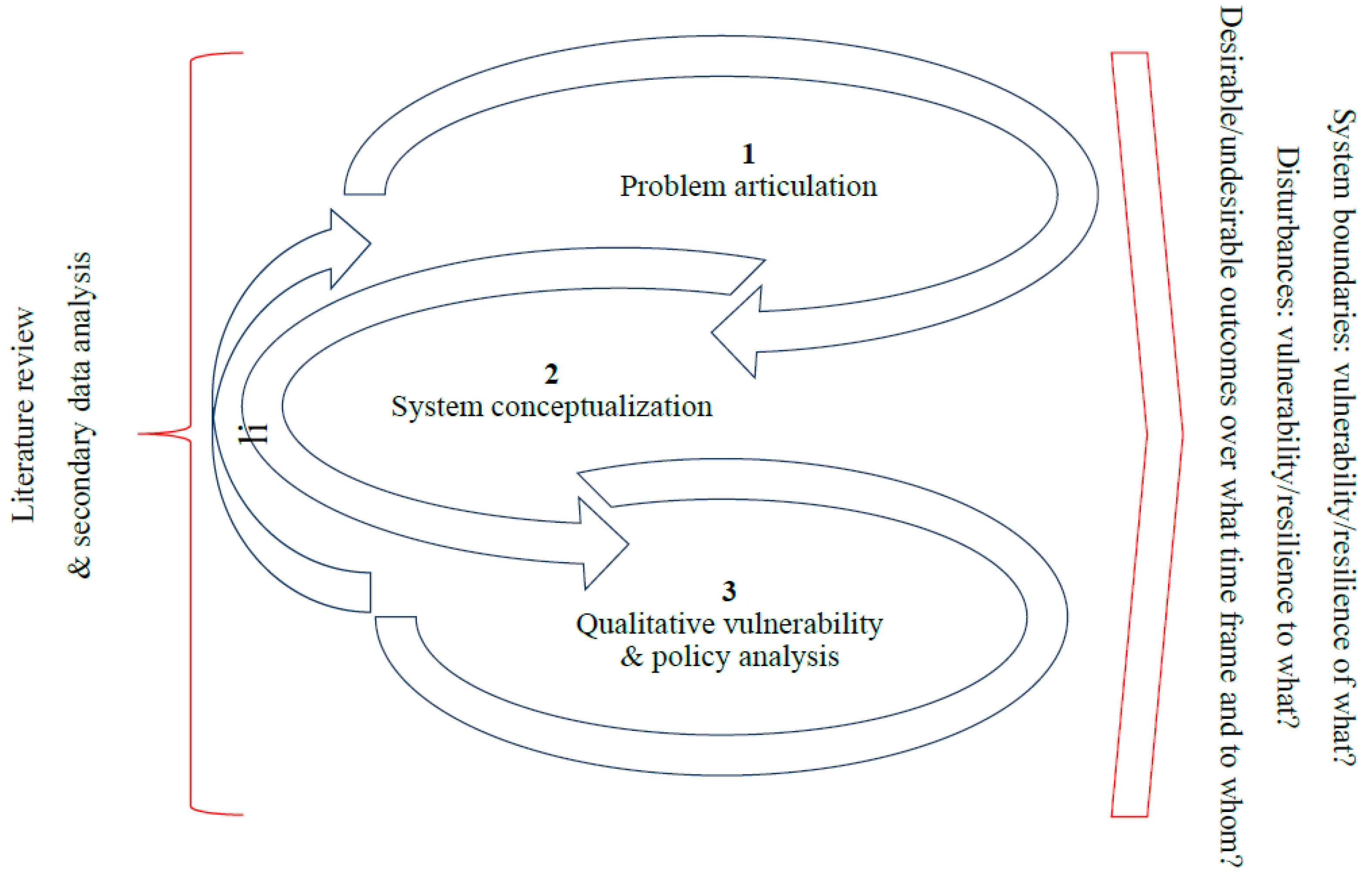
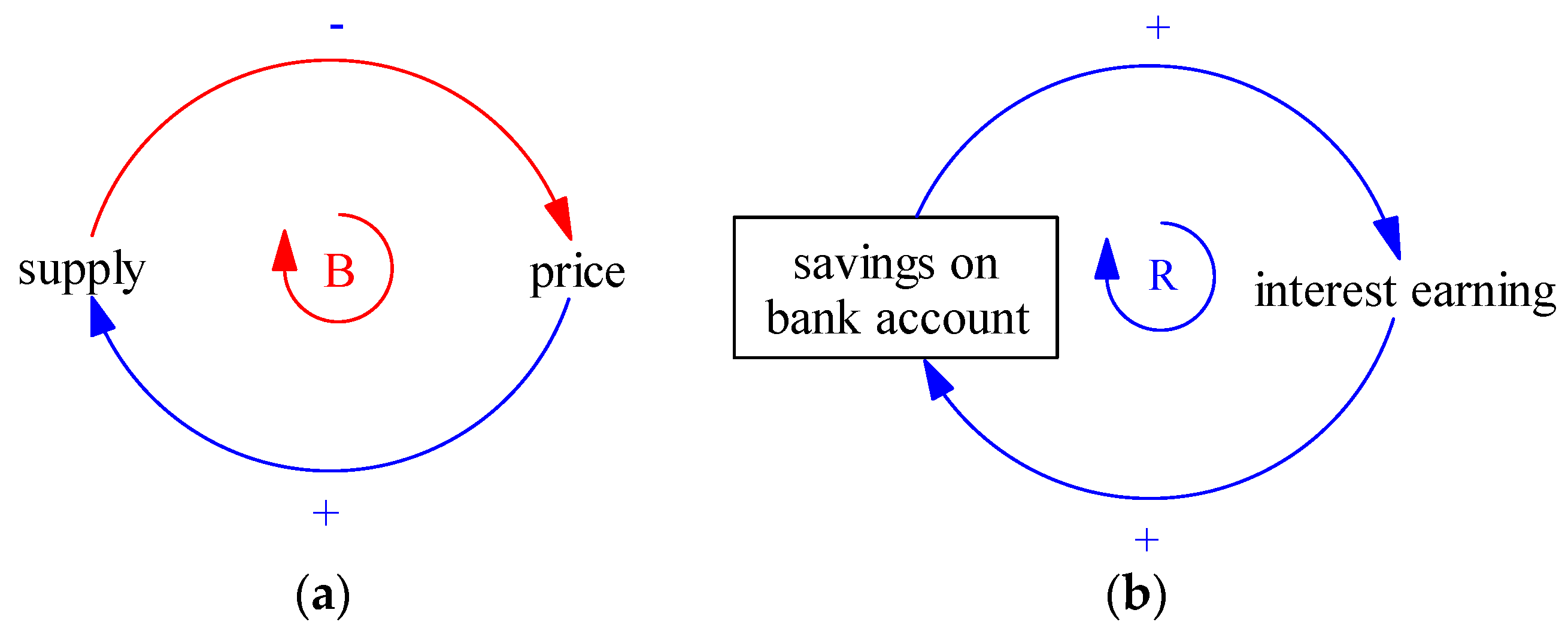
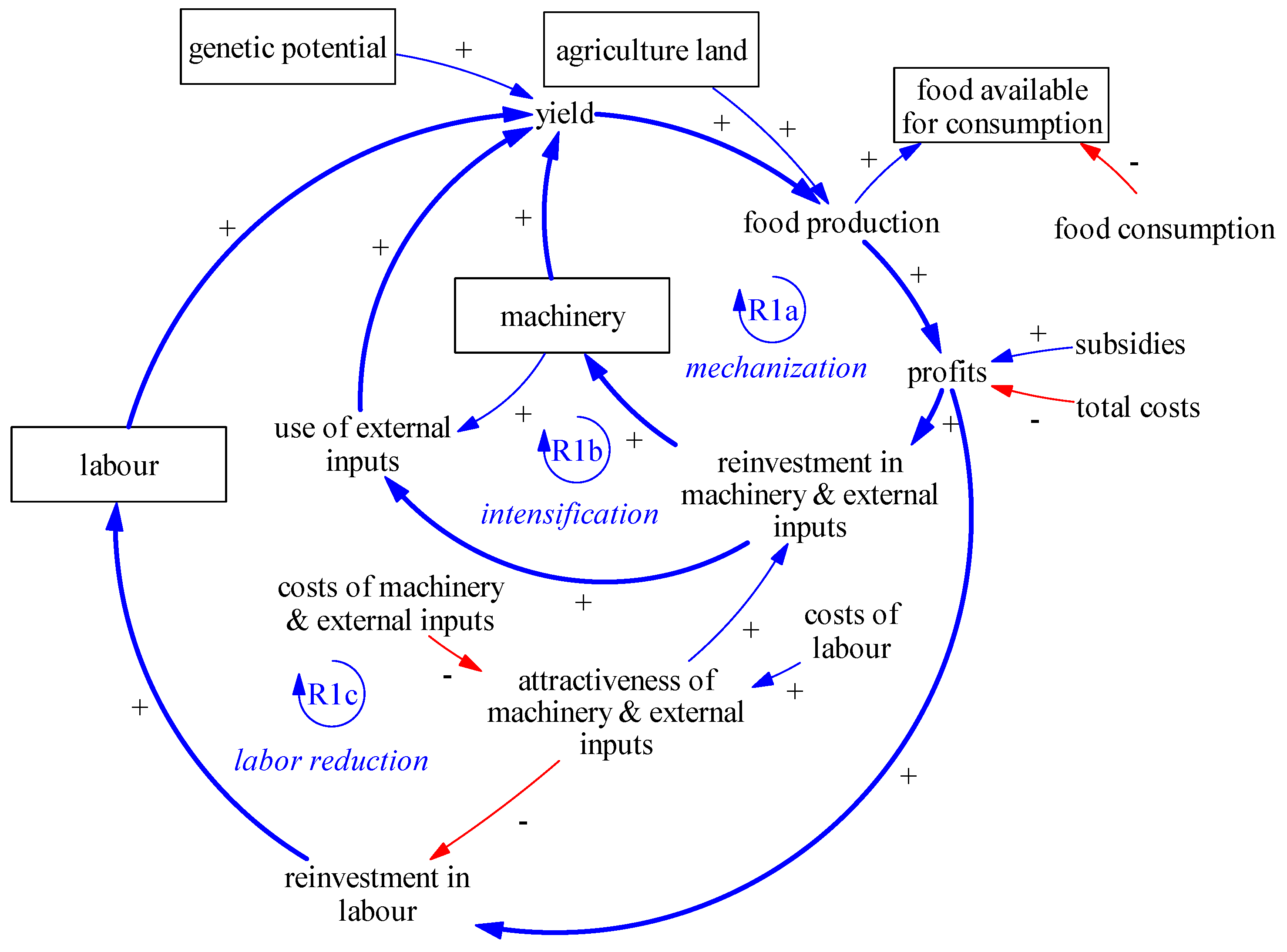
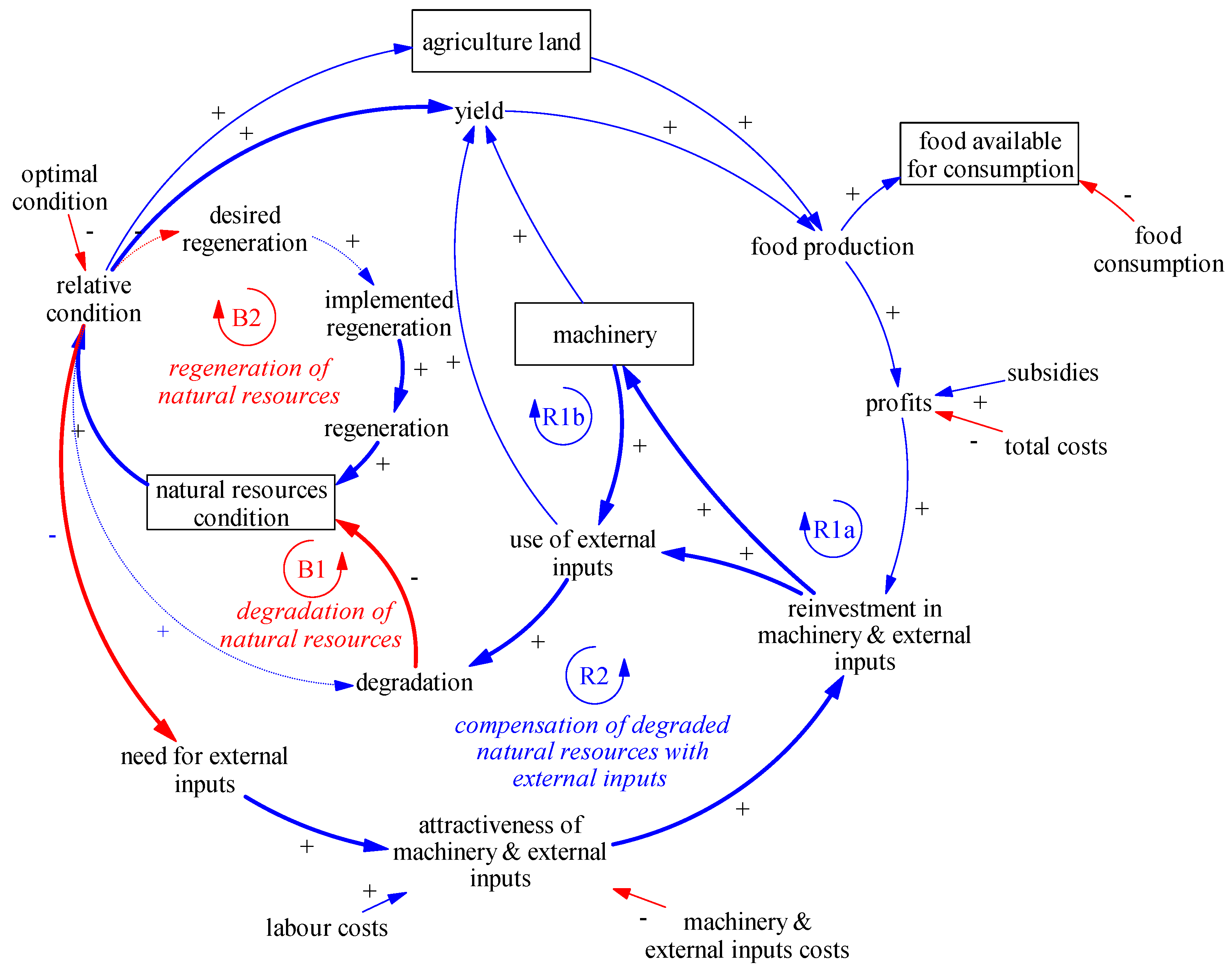
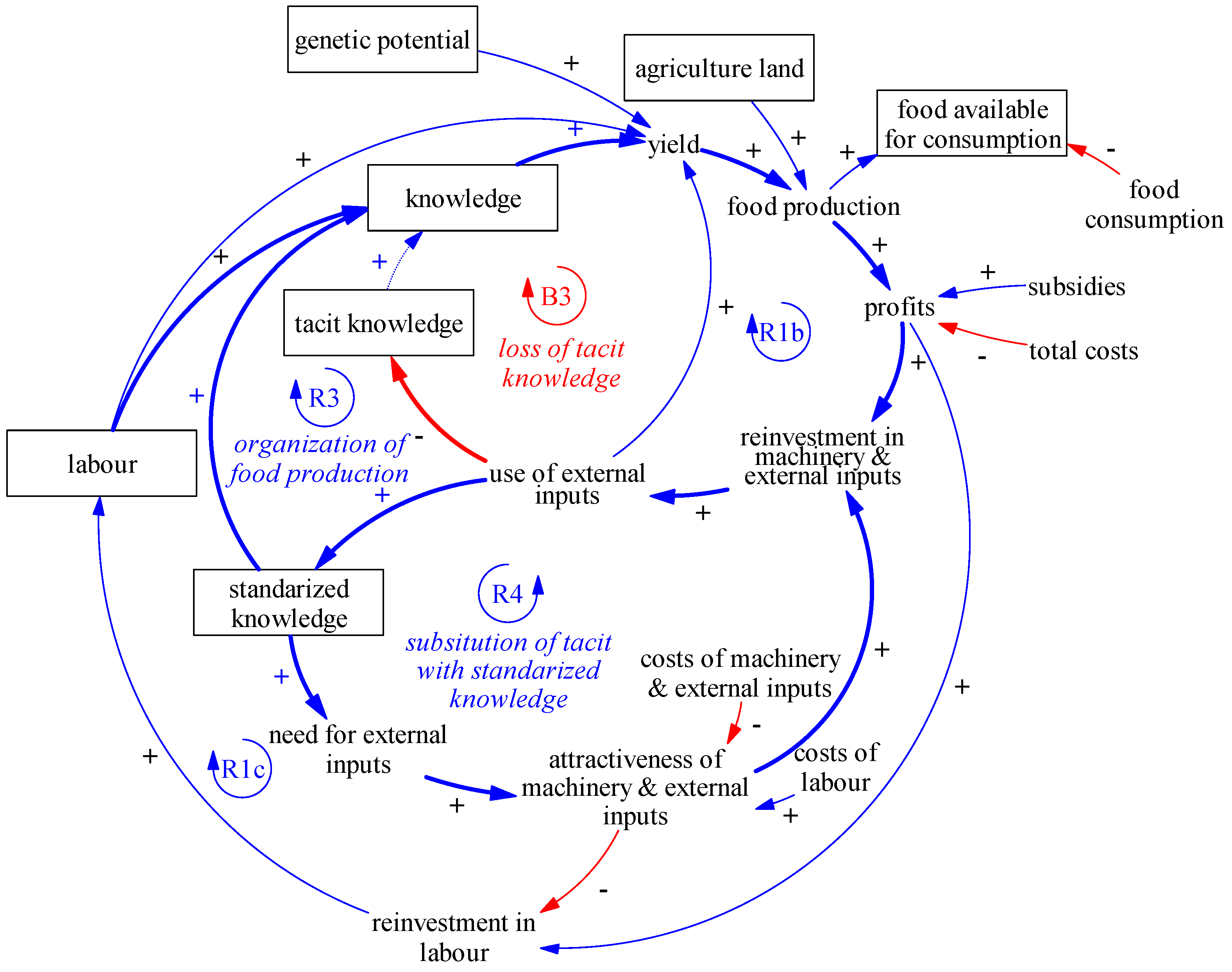
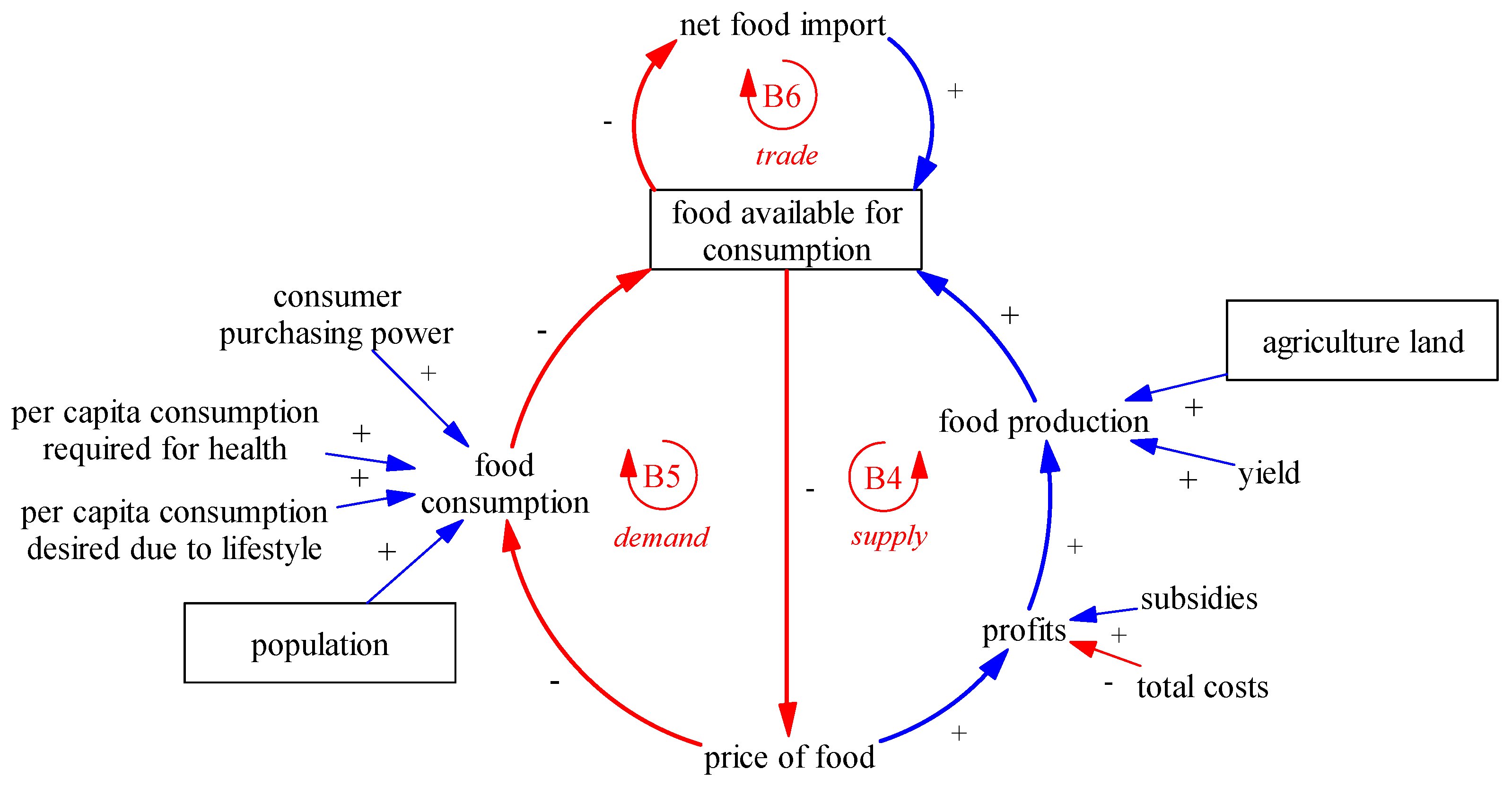
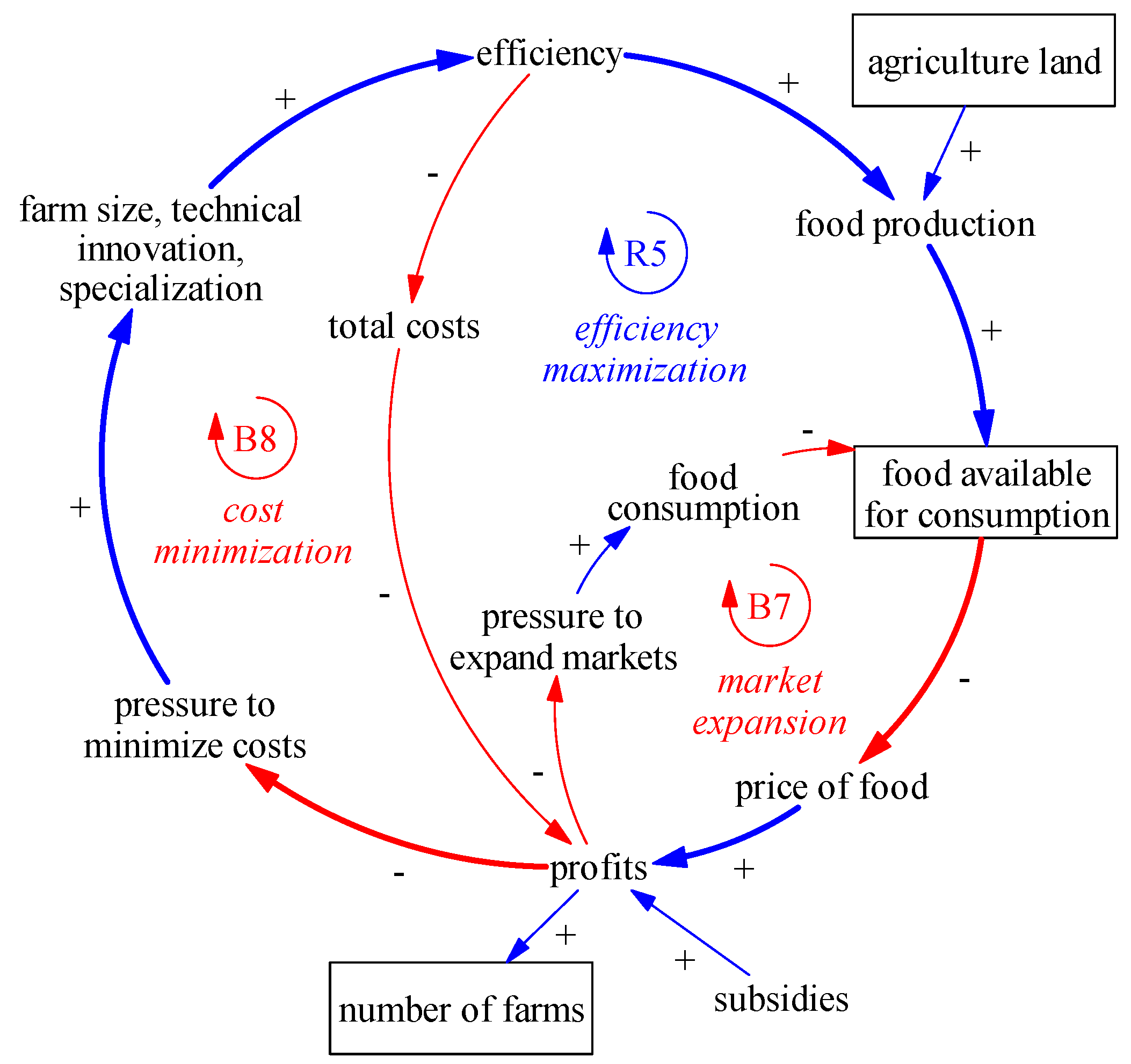
 )—examples of entry points for external drivers of change; some links are omitted for visual clarity.
)—examples of entry points for external drivers of change; some links are omitted for visual clarity.
 )—examples of entry points for external drivers of change; some links are omitted for visual clarity.
)—examples of entry points for external drivers of change; some links are omitted for visual clarity.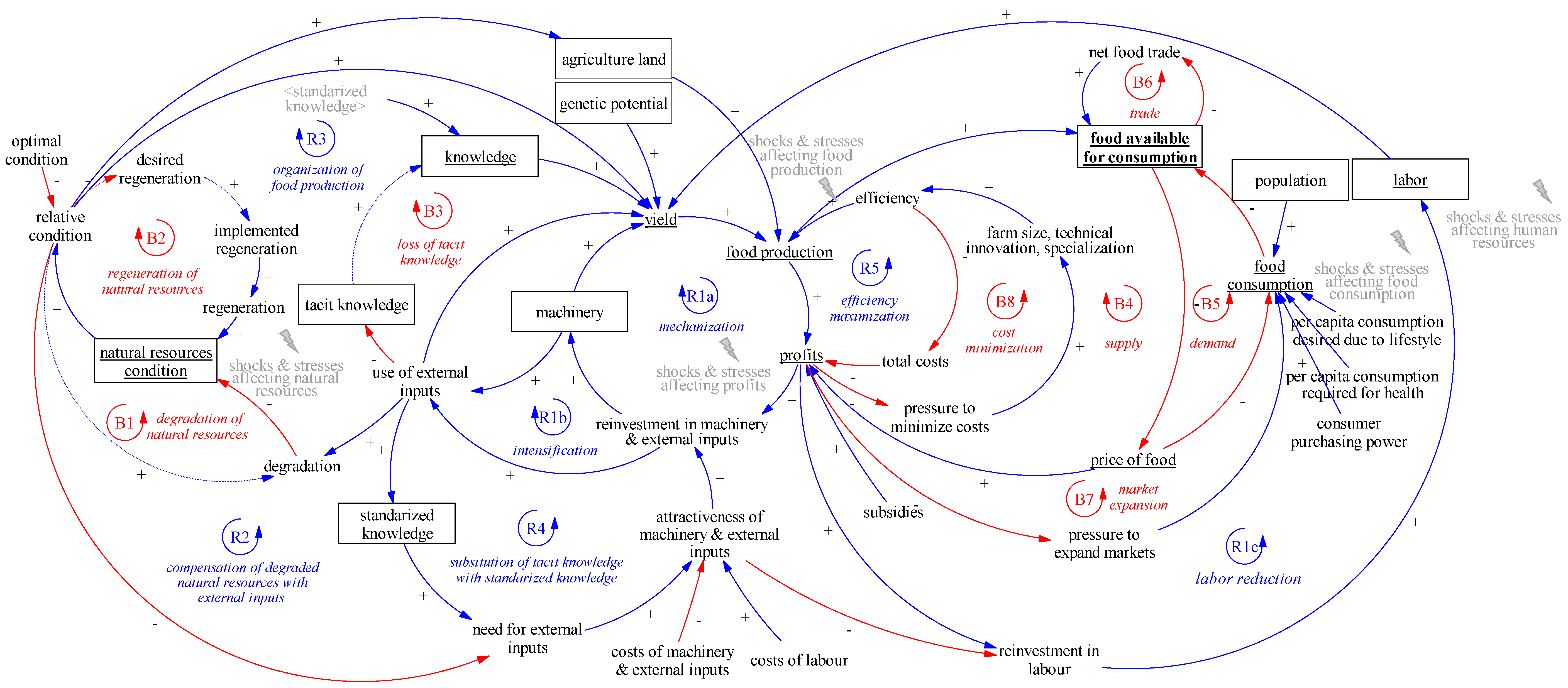
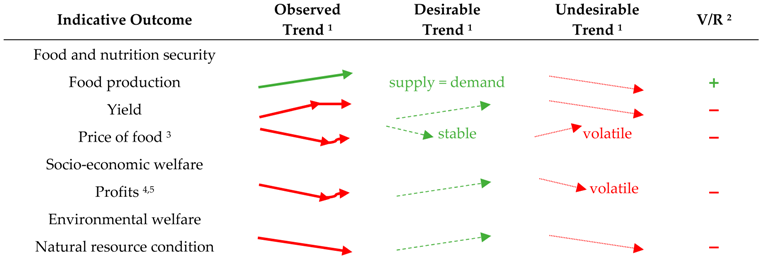 |
© 2016 by the authors; licensee MDPI, Basel, Switzerland. This article is an open access article distributed under the terms and conditions of the Creative Commons Attribution (CC-BY) license (http://creativecommons.org/licenses/by/4.0/).
Share and Cite
Brzezina, N.; Kopainsky, B.; Mathijs, E. Can Organic Farming Reduce Vulnerabilities and Enhance the Resilience of the European Food System? A Critical Assessment Using System Dynamics Structural Thinking Tools. Sustainability 2016, 8, 971. https://doi.org/10.3390/su8100971
Brzezina N, Kopainsky B, Mathijs E. Can Organic Farming Reduce Vulnerabilities and Enhance the Resilience of the European Food System? A Critical Assessment Using System Dynamics Structural Thinking Tools. Sustainability. 2016; 8(10):971. https://doi.org/10.3390/su8100971
Chicago/Turabian StyleBrzezina, Natalia, Birgit Kopainsky, and Erik Mathijs. 2016. "Can Organic Farming Reduce Vulnerabilities and Enhance the Resilience of the European Food System? A Critical Assessment Using System Dynamics Structural Thinking Tools" Sustainability 8, no. 10: 971. https://doi.org/10.3390/su8100971
APA StyleBrzezina, N., Kopainsky, B., & Mathijs, E. (2016). Can Organic Farming Reduce Vulnerabilities and Enhance the Resilience of the European Food System? A Critical Assessment Using System Dynamics Structural Thinking Tools. Sustainability, 8(10), 971. https://doi.org/10.3390/su8100971






